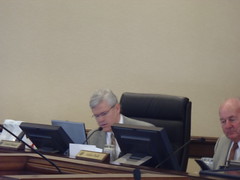Savannah and Jacksonville are among the east coast cities most vulnerable
to rising sea levels due to climate change, a study finds.
Savannah, Georgia’s main seaport, with storm surges, hurricanes,
and waves on top:
what will that look like?
Suzanne Goldenberg wrote for the Guardian today,
US coastal cities in danger as sea levels rise faster than expected, study warns:
Satellite measurements show flooding from storms like Sandy will put low-lying population centres at risk sooner than projected,
A
study published last March by Climate Central found sea-level rise
due to global warming had already doubled the risk of extreme flood
events — so-called once in a century floods — for dozens
of locations up and down the Atlantic and Pacific coasts.
It singled out the California cities of Los Angeles and San Diego on
the Pacific coast and Jacksonville, Florida, and Savannah, Georgia,
on the Atlantic, as the most vulnerable to historic flooding due to
sea-level rise.
Sandy, which produced a 9ft storm surge at Battery Park in New York
City, produced one example of the dangerous combination of storm
surges and rising sea level. In New York, each additional foot of
water puts up to 100,000 additional people at risk, according to a
map published with the study.
That study projected 6 inches rise at Fort Pulaski by 2030 (minimum 3 inches)
and 13 inches by 2050 (maximum 24 inches).
But projections have gotten worse since then:
 The latest research,
published on Wednesday in Environmental Research Letters,
found global sea-levels rising at a rate of 3.2mm a year, compared to the best estimates by the IPCC of 2mm a year, or 60% faster.
The latest research,
published on Wednesday in Environmental Research Letters,
found global sea-levels rising at a rate of 3.2mm a year, compared to the best estimates by the IPCC of 2mm a year, or 60% faster.
So that would be more like 9 inches by 2030 and 20 inches by 2050.
Add to a higher base sea level bigger storms like Hurricane Sandy,
and Savannah and Jacksonville have a problem.
Sure, Savannah is
Continue reading →
 I had the opportunity to talk with a county staff member
who said that the changes were to incorporate recent
amendments regarding
brown bagging, social hosts (serving
alcohol at private events to underage drinkers), and
the
Sunday package sales
into the body of the ordinance,
rather than having those items as amendments to the document.
Also, the setting of the license fees for Sunday
sales will be established
(from the referendum that passed 59.80% to 40.20%).
I had the opportunity to talk with a county staff member
who said that the changes were to incorporate recent
amendments regarding
brown bagging, social hosts (serving
alcohol at private events to underage drinkers), and
the
Sunday package sales
into the body of the ordinance,
rather than having those items as amendments to the document.
Also, the setting of the license fees for Sunday
sales will be established
(from the referendum that passed 59.80% to 40.20%).










